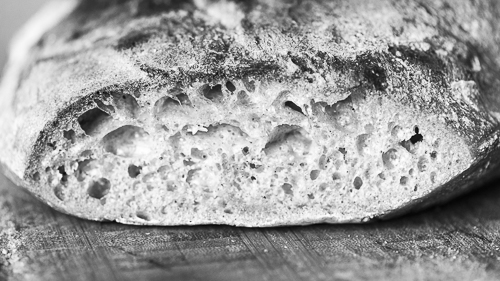A small bakery called «Ille bakeri» recently arranged a course on how to make a sourdough bread in 4 hours. Upon arrival at Mølleren Sylvia , the baker Martin Hveem Fjeld had put 11 bowls, one for each participant, on a table. Before starting the course, each of us should make a short presentation. Some of us had already made sourdough breads, but with very variable success. I had tried it once at another course, but I didn’t go on afterwards. Anyway, when we started baking, we were all on more or less the same level.
Martin had already made a sourdough starter, and having poured a fixed amount of water and sourdough starter in each bowl, we should first stir the mixture well. Next, he poured a fixed amount of wheat flour from Holli mill into each bowl, which we should stir until both water, starter and flour was mixed well together. Martin‘s only using wholemeal flour meaning that it contains both endosperm, germ and bran, keeping both taste and nutrients.
Source: https://en.wikipedia.org/wiki/Cereal_germ#/media/File:Wheat-kernel_nutrition.png
Gluten (from Latin gluten, “glue”) is a composite of storage proteins termed prolamins and glutelins and stored together with starch in the endosperm (which nourishes the embryonic plant during germination) of various grass-related grains.
Gluten is appreciated for its viscoelastic properties. It gives elasticity to dough, helping it rise and keep its shape and often gives the final product a chewy texture.
Holli mill grinds grain by means of millstones where the germ is ground into the flour such that it contains more fat than grinding by means of a roller mill, which is used for industrial production of flour.
Sourdough starters contain yeasts and lactic acid bacteria. While the yeasts expand bread by leaving air pockets after baking, the lactic acid bacteria improve taste, sight, smell and touch of bread as well as their shelf life, nutritional value and wholesomeness. A sourdough starter contains thousands of different microorganisms, which will leaven the bread much slower than when using baker’s yeast.
After about half an hour, we were told to pull the dough away from the wall of the bowl, then let it fall back again. After we had completed this task, we should let the dough rest for about one hour before repeating the same procedure. Since the dough was very wet, we needed to scrape off the dough from our hands and inside the bowls by means of a spatula. During the stay inside the bowl, we could observe formation of bubbles appearing in the dough, which was a sure sign that the yeasts were turning sugars into carbon dioxide. After a break, we restricted the fermentation by adding unrefined salt.
Besides, by adding salt, the gluten network in the dough is broken up such that it will be arranged anew and form stronger and more bonds. Since we added unrefined salt, which contains some essential trace elements in very small concentrations. The main ones are calcium, magnesium and sulphate, which, while they are there in tiny concentrations (parts per million), they are important to human health and to bread production.
Next, we should turn the bowl such that the opening faced downwards and scrape the dough out of the bowl, letting it fall down on a wooden table on which we had applied flour in advance. We tightened up the dough by means of a dough scraper. This consisted of holding the scraper obliquely and pushing it below the dough, forcing it upwards, then pulling the scraper out. It seemed very easy when Martin did it, but when I should do it, the dough was so sticky that it got attached to the scraper. Unsurprisingly, several of us needed help to finish this task.
After a break, we watched Martin turn the dough into a sausage-shape, folding the dough onto itself, pulling the far end of the dough left and right, braiding the parts of the dough and folding them back on the dough. Having done the same at the middle and near end, he put the dough into a basket called a banneton in which he first poured a small amount of rice flour. They are called hevekurv in Norwegian, meaning leavening basket, because they are used to let the dough leaven.
Next, we should do the same as he did, but almost all of us asked Martin to help us with this work, which seemed easy when he did it, but not so easy when we should do it. Finally, everyone had a banneton with sourdough and having got both sourdough starter, flour, spatulas, a razor blade with a wooden handle and a dough scraper, we left the premises. We were told to let the dough stay in a fridge for at least 12 hours before baking it and we should use the razor blade to make some cuts in the dough such it could expand through the cracks during baking.
I baked the bread, but I had to lower the temperature from the recommended 250ºC to about 175ºC because the crust was getting burnt. After baking, I had a delicious sourdough bread for a few days.
For those who are interested in knowing more Martin’s breads, he has made a book on the breads with a couple of friends. It can be found in Norwegian here and in English here. He arranges courses occasionally and they can be found at his web page.
Making a sourdough bread or any other bakery product from sourdough entails using the same procedure for baking as was done from the dawn of civilisation to about 1900 when baker’s yeast started replacing sourdough.
As a follow-up, The Ultimate Guide to Sourdough Bread might come in handy.

